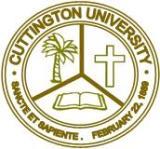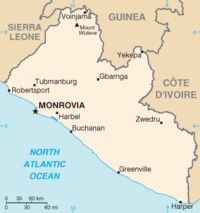Cuttington University
 | |
| Motto | Sancte Et Sapiente |
|---|---|
| Type | Private |
| Established | 1889 |
| Location | , 7°02′24″N 9°33′15″W / 7.0400000°N 9.5541667°W[1] |
| Affiliations | Episcopal Church of the United States |
| Website | www.cuttington.org |
Cuttington University is a private university in Suacoco, Liberia. Founded in 1889 as Cuttington College by Episcopal Church of the United States (ECUSA), it is the oldest private, coeducational, four-year, degree-granting institution in sub-Saharan Africa.[citation needed]
History
In 1887, Robert Fulton Cutting, treasurer of the ECUSA, donated $5000 to an Episcopalian bishop in Liberia for the establishment of a school for teaching the children of the African-American settlers and native Liberians about industry and agriculture.[2] The university was finally established in 1889 by Samuel David Ferguson in Cape Palmas where it remained until 1929. Named Cuttington College when it opened, M. P. Keda Valentine served as the first principal followed by Samuel Taylor.[2] Among the first private colleges in the West African region, the school was seen as a college for Liberia's elite.[3] Some of the earliest graduates included "two chief justices of the Liberian Supreme Court and three associate justices, one minister of education and many civil servants".
In 1948, the college moved to Suacoco in Bong County 120 miles north of Liberia's capital of Monrovia. Prior to the First Liberian Civil War, 45% of government officials were alumni of the college.[3] During the First Liberian Civil War from 1989 to 1996 the school was looted and the structures were damaged and the campus used as a training facility for militias.[3] From 1990 to 1997 the school operated only at an office in the U.S. state of Virginia.[3] In 1998, the now Cuttington University College re-opened with a class of 103 students.[3]
The college has now reopened for the third time in its history (the second founding was at its current location was in 1948), after a lengthy period of civil conflict. On August 15, 2004, 117 students graduated on the war-ravaged campus in various disciplines, with the highest number of graduates being in nursing.
War damage
On February 5, 2004, the President of Cuttington, Dr. Henrique F. Tokpa met his son Captain Matthew J. Denkyan of the U.S. Army who is assigned to Liberia as a military observer. They were part of an inspection team who toured the partially renovated facilities which had been damaged by looters during the war.
- The Dunbar Building, which houses the office of Registrar; bookstore and a few classrooms had been de-roofed and heavy and repeated rain storms had damaged the ceiling, roofing frame and nearly all of the books that had been previously donated by the County College of Morris in Randolph, New Jersey, USA.
- The AFRICANA Museum is in similar condition to the Dunbar Building (zinc and ceiling material have been removed by looters and the roofing timbers had been exposed to the weather and only the concrete walls and rafters remained in place.
- The Tubman Library had sustained less structural damage, but extensive looting and on site destruction of books and facilities has taken place there.
- The Seth C. Edwards cafeteria has been partially de-roofed and some of the roofing timbers had collapsed.
- A grass fire had destroyed a building that had been built by the Lutheran Church as the guest house for commuting professors. The fire had created extensive cracks in the structure and will have to be demolished. The cause of the grass fire is unknown, but during the dry Harmattan season grass fires are common, but during the war they burned out of control.
- The newly constructed Power House which was constructed with a USAID and ASHA grant is relatively intact although looters entered the building, less damage was done.
Details

Cuttington University is the oldest private, coeducational, four-year, degree-granting institution in sub-Saharan Africa.[citation needed] It issues degrees in the liberal arts and a number of technical studies. It has educated generations of leaders for the nation of Liberia and West Africa. Its roots lie deep within the history of the nation, the relationship between Liberia and the United States, and the Episcopal Church.
Currently the school is attempting to find sponsors who will help to improve its communications with the world. Since the end of the war, regular telephone, electricity, and internet service have been restored. The campus also runs its own water treatment facility. At present a volunteer web site is maintained remotely in the United States. The Cuttington University public radio and television stations plan to resume broadcasts by January, 2010.
The campus, 120 miles from Monrovia, includes single-story white structures.[3] These are set among rolling hills and cotton trees as well as rice paddies and the native tropical plants.[3] Next to campus is the school's affiliated hospital, Phebe Hospital.[3]
Notable people
- Harry Moniba, alumni, Vice President of the Republic of Liberia from 1984 - 1990.
- Wilton Sankawulo, faculty member and author[4][5]
- Jewel Taylor, student, former First Lady
References
- ^ "Cuttington College, Bong County, Liberia". glosk.com. Retrieved 2008-09-01.
- ^ a b Saha, Santosh C. “Agriculture in Liberia during the Nineteenth Century: Americo-Liberians' Contribution”, Canadian Journal of African Studies, Vol. 22, No. 2 (1988), Canadian Association of African Studies, pp. 224-239.
- ^ a b c d e f g h Rossouw, Henk. “A Liberian University Rises Up From the Ravages of War”, The Chronicle of Higher Education, November 9 2001, International, p. 58.
- ^ Sankawulo, Wilton. Great Tales of Liberia as told by Wilton Sankawulo ISBN 973-651-838-8
- ^ Sankawulo, Wilton. Sundown at Dawn: A Liberian Odyssey ISBN 0-9763565-0-3.
